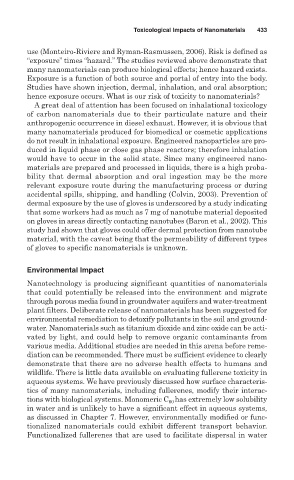Page 456 - Environmental Nanotechnology Applications and Impacts of Nanomaterials
P. 456
Toxicological Impacts of Nanomaterials 433
use (Monteiro-Riviere and Ryman-Rasmussen, 2006). Risk is defined as
“exposure” times “hazard.” The studies reviewed above demonstrate that
many nanomaterials can produce biological effects; hence hazard exists.
Exposure is a function of both source and portal of entry into the body.
Studies have shown injection, dermal, inhalation, and oral absorption;
hence exposure occurs. What is our risk of toxicity to nanomaterials?
A great deal of attention has been focused on inhalational toxicology
of carbon nanomaterials due to their particulate nature and their
anthropogenic occurrence in diesel exhaust. However, it is obvious that
many nanomaterials produced for biomedical or cosmetic applications
do not result in inhalational exposure. Engineered nanoparticles are pro-
duced in liquid phase or close gas phase reactors; therefore inhalation
would have to occur in the solid state. Since many engineered nano-
materials are prepared and processed in liquids, there is a high proba-
bility that dermal absorption and oral ingestion may be the more
relevant exposure route during the manufacturing process or during
accidental spills, shipping, and handling (Colvin, 2003). Prevention of
dermal exposure by the use of gloves is underscored by a study indicating
that some workers had as much as 7 mg of nanotube material deposited
on gloves in areas directly contacting nanotubes (Baron et al., 2002). This
study had shown that gloves could offer dermal protection from nanotube
material, with the caveat being that the permeability of different types
of gloves to specific nanomaterials is unknown.
Environmental Impact
Nanotechnology is producing significant quantities of nanomaterials
that could potentially be released into the environment and migrate
through porous media found in groundwater aquifers and water-treatment
plant filters. Deliberate release of nanomaterials has been suggested for
environmental remediation to detoxify pollutants in the soil and ground-
water. Nanomaterials such as titanium dioxide and zinc oxide can be acti-
vated by light, and could help to remove organic contaminants from
various media. Additional studies are needed in this arena before reme-
diation can be recommended. There must be sufficient evidence to clearly
demonstrate that there are no adverse health effects to humans and
wildlife. There is little data available on evaluating fullerene toxicity in
aqueous systems. We have previously discussed how surface characteris-
tics of many nanomaterials, including fullerenes, modify their interac-
has extremely low solubility
tions with biological systems. Monomeric C 60
in water and is unlikely to have a significant effect in aqueous systems,
as discussed in Chapter 7. However, environmentally modified or func-
tionalized nanomaterials could exhibit different transport behavior.
Functionalized fullerenes that are used to facilitate dispersal in water

